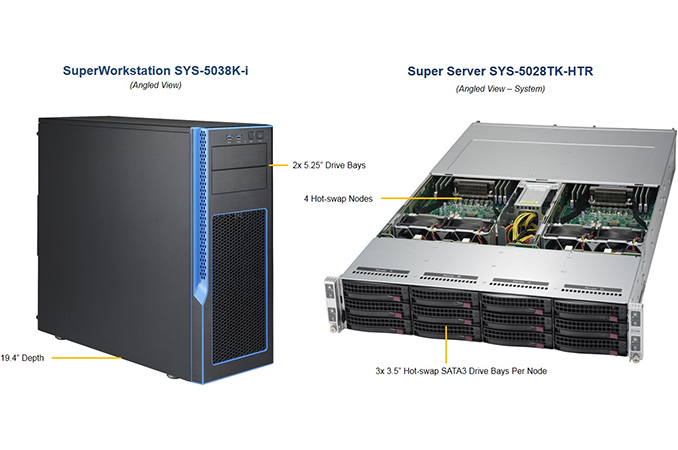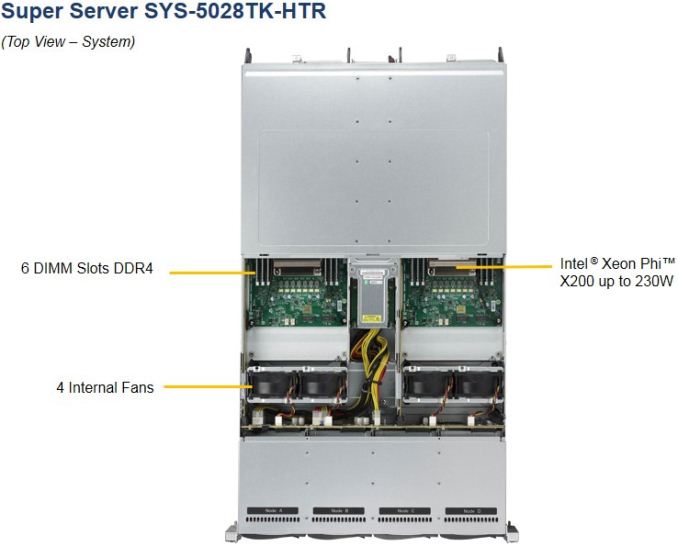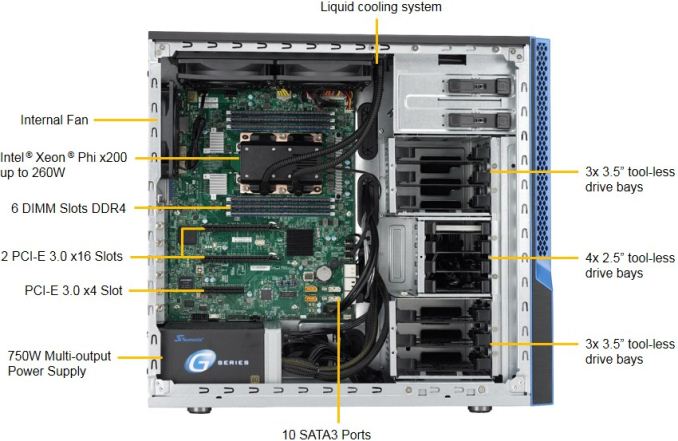Supermicro Releases Intel Xeon Phi x200 (KNL) Systems: Servers and a Developer Mid-Tower
by Anton Shilov on August 23, 2016 8:15 AM EST- Posted in
- Enterprise
- CPUs
- Intel
- Supermicro
- Xeon Phi
- Servers

Supermicro has released two systems featuring Intel’s many-core Xeon Phi x200 processors: a workstation and an ultra-dense server. The platforms support up to 384 GB of DDR4 memory and are based on the good-old Intel C612 PCH. Due to high TDP of Intel’s Knights Landing CPUs, Supermicro had to use a custom closed-loop liquid cooling for its SuperWorkstation SYS-5038K-i.
Intel officially launched its Xeon Phi x200 many-core Knights Landing platform in June, but the company disclosed most of the details regarding its new processors last year at Supercomputing15. As discussed, every Xeon Phi x200 in LGA packaging has up to 72 cores (based on highly-modified Atom Silvermont microarchitecture) running at up to 1.5 GHz, with up to 36 MB of L2 cache, 16 GB of on-package high-performance memory (MCDRAM), six-channel DDR4 DRAM controller as well as 36 PCIe 3.0 lanes. The Xeon Phi x200 chips in LGA3647 form-factor can run as a host, directly with an operating system on board (including Windows Server 2016) which is an upgrade over the older Xeon Phi parts which only ran as co-processors on the PCIe bus. Moreover, the internal PCIe 3.0 root complex gives the Xeon Phi some PCIe lanes to allow other coprocessors to be plugged in - either additional Xeon Phi accelerators in the card form-factor, or AMD/NVIDIA cards, to maximize the compute horsepower.
SuperServer 5028TK-HTR
Since Intel Xeon Phi x200 processors are designed mainly for high performance computing, so as a result the OEM developers that build servers for customers tend to focus their efforts primarily on ultra-dense platforms.
One of the first Xeon Phi x200 solutions from Supermicro will be the SuperServer 5028TK-HTR, which packs four hot-swappable half-width nodes based on the company’s K1SPi motherboards into a 2U form-factor. Each 5028TK-HTR sports 12 3.5” hot-swappable SATA/SAS storage devices (three per node) as well as a 2000 W redundant PSU. Meanwhile, the K1SPi carries one P1 socket, six DDR4 DIMM slots (for up to 384 GB of DDR4), two PCIe 3.0 x16 low-profile slots, a PCIe 3.0 x4 slot, an Intel i350 dual port GbE controller, the Aspeed AST2400 BMC platform management.
Supermicro’s SuperServer 5028TK-HTR (as well as the K1SPi motherboard) support Intel Xeon Phi x200 processors with up to 250-260 W TDP. Machines supporting Knights Landing models featuring Omni-Path fabric will be announced at a later date.
SuperWorkstation 5038K-i
While HPC is a very important market for products like Xeon Phi, there is a segment of Xeon Phi clients who use them in desktop environments for financial analysis, oil and gas exploration, simulations as well as other applications. Also, HPC developers typically want a system-under-the-desk to actually develop their software with immediate results. Specifically for them, at the request of Intel, Supermicro introduced its SuperWorkstation 5038K-i desktop machine featuring the company’s K1SPE motherboard. The workstation is a self-contained unit sold complete, with CPU, DRAM, storage, PSU and cooling.
The chassis can fit in two 5.25” ODDs (or other peripherals), six 3.5" and four 2.5” storage devices. The tower is equipped with multiple fans and come with one 750W power supply made by Seasonic as well as a custom-made closed-loop liquid cooling system with two 120 mm fans.
The K1SPE mainboard features one P1 socket (with eight-phase power delivery), six DDR4 DIMM slots (for up to 384 GB of DDR4), two PCIe 3.0 x16 slots, a PCIe 3.0 x4 slot, 10 SATA connectors, two GbE ports (via Intel i350), an IPMI LAN port, Aspeed AST2400 for graphics and management, USB 3.0 ports and so on. Despite the fact that the K1SPE uses regular ATX form-factor (with ATX12V and EPS12V power connectors), it will not be sold separately.
Both SuperServer 5028TK-HTR and SuperWorkstation 5038K-i machines should be available from Supermicro shortly, but only as complete systems. Therefore, their exact pricing could not be determined because it depends completely on exact configurations and quantity. We have been told that the workstation, the 5038K-i, is actually on back order with a number of customers already, however Supermicro is ramping up production as a result.
Additional from Ian: We've put in a request for a 5038K-i sample, which will run Windows Server 2016. As it's a full x86 core (with additional VPUs), I want to see how well our regular x86 enterprise workloads translate into the Xeon Phi sphere. With a low single thread frequency but up to 72 cores, this test should be an interesting one.
Source: Supermicro


















8 Comments
View All Comments
ddriver - Tuesday, August 23, 2016 - link
Superservers and superworkstations sound oddly childishly named.Curious how the phi would do in traditional workstation (not enterprise) tasks as a main processor.
nathanddrews - Tuesday, August 23, 2016 - link
My guess is that it would be really slow for the majority of tasks, but be extraordinary at very threaded tasks. Pricing will be the primary consideration, I think. I'm not aware of any workstation applications that benefit from having more than 8-10 cores, so you might be better off with a dual Xeon setup or something so you can get high single threaded performance and probably faster multithreaded performance. (unless your applications use 50 threads...)I'm sure there are applications/scenarios where this excels, I just can't think of any. Can't wait for benchmarks!
ddriver - Tuesday, August 23, 2016 - link
Well, most demanding tasks in HPC actually scale quite well, almost perfectly. Those usually divide the work and do it in multiple passes. However I am also curious about async massive multithreading scenarios, where scores of thread do their own thing and exchange results rather than working on parts of the same workload.mtroute - Thursday, September 8, 2016 - link
Don't expect screen melting geekbench scores. To take advantage of Phi codes need to be optimized considerably. Vectorization, data locality, memory and cache optimization. This is a true parallel processor that with the right code modernization, will melt your screen..Kevin G - Tuesday, August 23, 2016 - link
Yes, I'm eager to see how a high thread count, low IPC platform does across an array of tasks. Even though they're Atom based cores, I'm eager to see if performance is 'good enough' for the per thread aspect while exploiting the massive amount of parallelism for high throughput.ddriver - Tuesday, August 23, 2016 - link
"atom based" doesn't mean much in terms of actual performance, at least the kind of performance I am interested in, actually comes from the SIMD units, and this thing has 512bit wide simd while atoms don't even have avx - that is they cap out at sse3, which suggests the simd units are 128bit wide.So while this may have low IPC for scalar, this is by far not the case for vector execution, which matters for practically 100% of the computation intensive tasks.
beginner99 - Wednesday, August 24, 2016 - link
I would like to have that one and also know some scenarios were it would be great. Now I will have to wait 10 years till software catches up...BlueBlazer - Wednesday, August 24, 2016 - link
A review of that workstation would be nice, at least we can see how Intel's Knights Landing actually performs (including workstation and server style workloads).